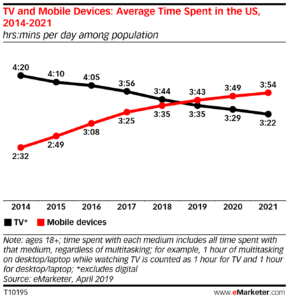According to Mobile Marketing Magazine, mobile advertising such as display advertising spending in the US is expected to reach up to $165.7 billion in 2019. This sort of spending is not due in part by the hopes that mobile advertising is trendy, and big business want to ride the coat tail as far as it will go. No, this massive amount of spending on mobile advertising is because it works. It works because the average adult spent 3 hours and 43 min on their device daily in 2019 via a study by emarketer.

So, what is display advertising?
“Display advertising is advertising on websites or apps or social media through banners or other ad formats .” Wikipedia

image via SproutSocial.com
What is Programmatic display advertising?
Programmatic is just the buying of ad space through automation using software.
Mobile advertising is also not just for big businesses with million-dollar marketing budgets. It is for any type of business that sees true value and power in strategic, fully optimizable and completely trackable mobile advertising efforts.
Even with mobile advertising reigning as king, desktop-based digital ads have been at a steady decline while mobile display advertising have been rocketing skyward. With the increase of smart phones and tablets, desktop computers and laptops have taken a seat in the second row. However, companies are still starting their digital planning strategies with desktop and tablet top-of-mind.
Mobile display advertising needs to become the go-to mindset for truly successful digital strategies to accommodate and keep up with the mobile-driven society we have become. And with some trusted and proven techniques, you can easily optimize your digital display advertising for mobile users who are always on-the-go.
There are a few types of mobile display advertising that may fit your companies marketing goals:
Location Targeting
Reach your customers, nearly anywhere in the world, with geofences. Geofences are digital areas that can be strategically set up around targeted locations in order to more accurately reach your potential customers. Airports, malls, hotels, shopping districts and even your competitors can all be targeted by your ads!
Calls-to-Action
There are many different types of calls-to-action to consider: Click-to-call, click-to-download, map-to-directions, coupon downloads, watch video and many more. Running some A/B testing to learn how best to interact with your target market will make your efforts more exact and will ideally yield more return on investment.
Time Targeting
You can select the exact time and date you would like your ads to be shown to your target market. With this level of control, you can run more A/B tests to determine most effective times/dates to send future ads. Plus, all ads that are active can be tracked and altered in real-time.
Demographic or Interest Targeting
Use the information you already have on your target market and target them based on their interests and demographics. Sports lovers, millennial music enthusiasts and female jet-setters are all easily targeted via mobile display marketing techniques.
Once you start trying and testing a few different mobile display marketing techniques, you will be able to scour through all the data and create even better marketing campaigns in the future. People change; therefore, you will have to adapt to reach potential consumers. Continuously running tests and analyzing data will keep your marketing efforts fresh and relevant.
As mobile advertising continues to grow in popularity, without a decline in the foreseeable future, now is the best time to jump in and start thinking smart about your mobile advertising goals. Contact Thumbvista to help you develop a strategic mobile display advertising campaign, today.

